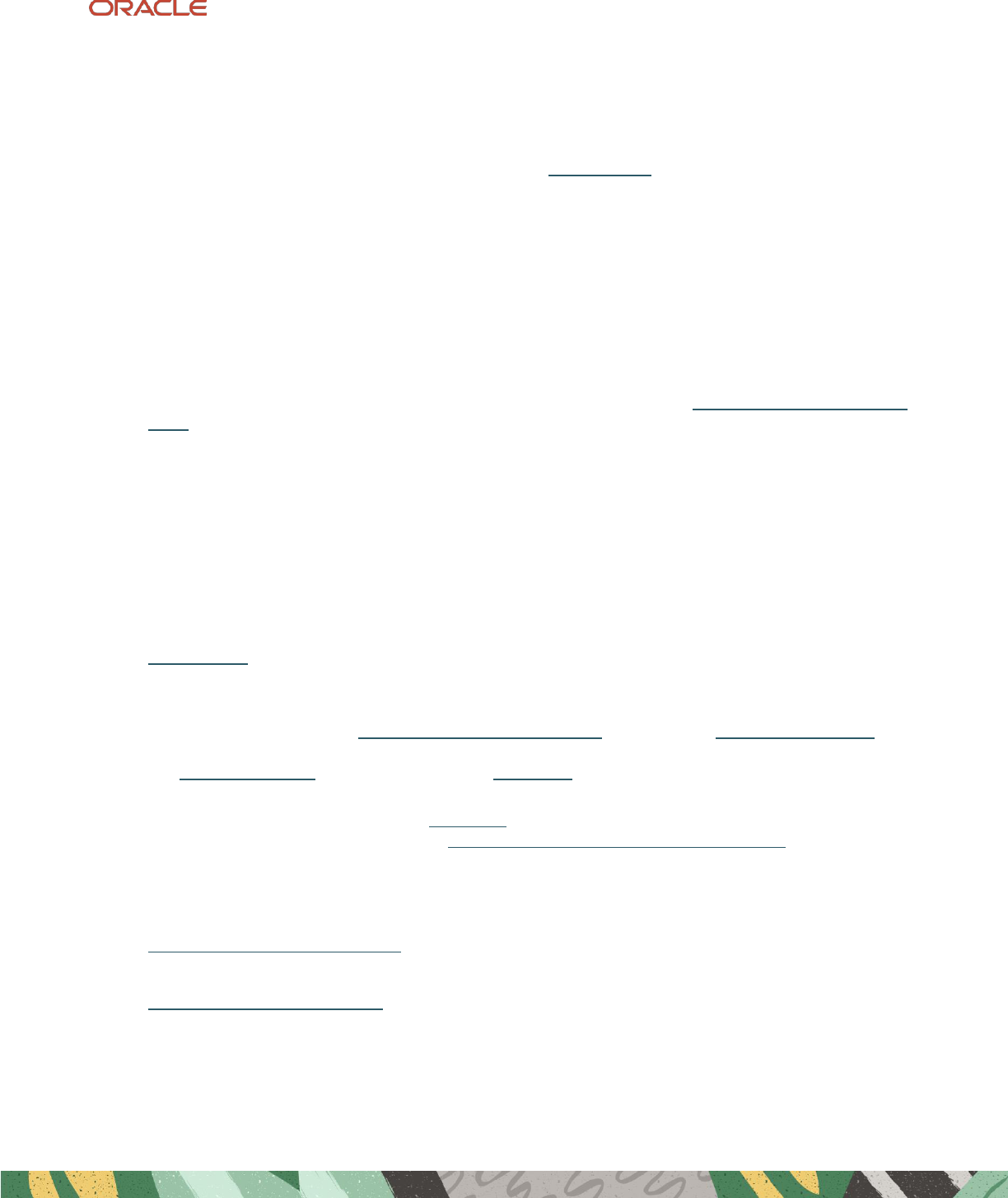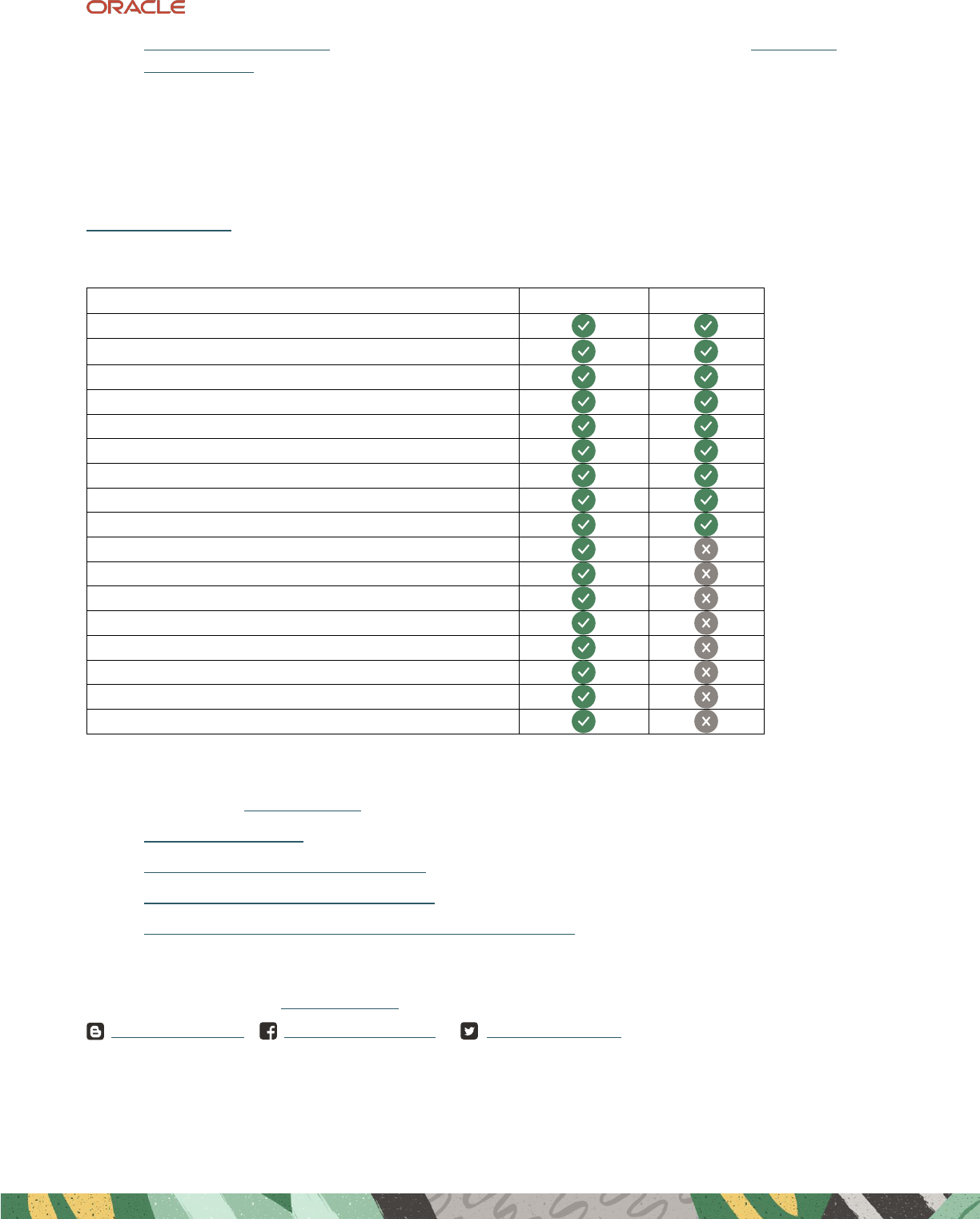
1 Oracle Linux data sheet
Copyright © 2024, Oracle and/or its affiliates / Public
Oracle Linux
A secure and high performance operating environment, Oracle Linux delivers the operating system,
virtualization, management, automation, and cloud native computing tools in a single, easy-to-
manage support offering. Oracle Linux provides a 100% application binary–compatible alternative to
Red Hat Enterprise Linux and CentOS Linux and is supported across both distributed and multicloud
environments.
Software features and benefits
Choice of OS kernels:
• Oracle Linux comes with a choice of two kernels for the x86_64 platform: the Unbreakable Enterprise Kernel
(UEK), which is installed and enabled by default, and the Red Hat compatible kernel (RHCK). For the Arm
(aarch64) platform, Oracle Linux ships with the UEK kernel.
• UEK delivers the latest Linux operating system innovations and business-critical performance and security
optimizations for cloud and on-premises deployments, while providing binary compatibility with applications
certified to run on Red Hat Enterprise Linux (RHEL). UEK Release 7, based on the mainline long term support
(LTS) Linux kernel version 5.15, includes many upstream enhancements and is available with Oracle Linux 8
and 9.
• RHCK, like UEK, enables users to run their existing RHEL-compatible software on Oracle Linux without
modification. RHCK users also have access to additional fixes from Oracle.
Security and compliance:
• Oracle Ksplice provides zero-downtime patching for the kernel, hypervisor, and critical user space libraries
without requiring a reboot or interruption.
• Ksplice known exploit detection enables auditing and alerting for known privilege escalation vulnerabilities.
• Oracle Linux 8 has received a Common Criteria (CC) Certification and completed FIPS 140-2 validations of its
cryptographic modules. Oracle Linux KVM and Oracle Linux Virtualization Manager have also completed the
first KVM CC evaluation. FIPS 140-3 validation is in progress for several cryptographic modules in Oracle
Linux 8 and Oracle Linux 9.
• Oracle Linux has an open source utility, OpenSCAP (Security Content Automation Protocol), for testing
security compliance against the published STIG (Security Technical Implementation Guide).
Virtualization:
• Kernel-based Virtual Machine (KVM) hypervisor is included with Oracle Linux, supporting Intel VT-x and VT-d
hardware extensions and Secure Encrypted Virtualization (SEV) for AMD-V enabled processors.
• Oracle Linux Virtualization Manager configures, monitors, and manages Oracle Linux KVM environments.
Containers and orchestration:
• Oracle Cloud Native Environment is software for configuring, deploying, updating, and upgrading
infrastructure for running cloud native applications. It is based on open standards, specifications, and APIs
defined by the Open Container Initiative and Cloud Native Computing Foundation (CNCF), including a CNCF-
certified Kubernetes module, container runtimes, service mesh, storage, networking, observability, and
diagnostics.

2 Oracle Linux data sheet
Copyright © 2024, Oracle and/or its affiliates / Public
File systems:
• XFS is the default file system for Oracle Linux 7, 8, and 9.
• Additional file systems include Btrfs, for large storage subsystems; Oracle Cluster File System 2 (OCFS2), a
general purpose, extent-based clustered file system; and Gluster Storage for Oracle Linux, a scalable,
distributed file system.
• Oracle Linux also supports the T10 Protection Information Model (T10-PIM) to help prevent silent data
corruption.
High availability:
• High availability services in Oracle Linux consist of several open source packages, including the Corosync and
Pacemaker features. These tools enable you to achieve high availability for applications and services that are
running on Oracle Linux.
• Oracle Linux provides load balancing of network traffic with two integrated software components: HAProxy
and Keepalived. The HAProxy feature provides load balancing and high-availability services to TCP and
HTTP, while Keepalived performs load balancing and failover tasks on both active and passive routers. The
NGINX software component can also be used in Oracle Linux for load balancing.
• Oracle Clusterware provides a server failover capability that helps protect Oracle and non-Oracle applications.
It can be a valuable component of a business continuity infrastructure for applications and databases
managed in a cluster environment.
Management tools:
• Oracle Linux Automation Manager and Engine, based upon the open source AWX and Ansible projects
respectively, enables users across an organization to create, share, and manage infrastructure automation
tasks.
• Oracle Linux Manager provides tools for managing the Oracle Linux software lifecycle. It also helps automate
a kickstart installation, system configuration, and maintenance tasks.
• Oracle OS Management Hub simplifies the management and monitoring of updates and patches for Oracle
Linux systems across distributed environments, through a centralized management console.
• DTrace, a dynamic tracing framework, provides insight into the behavior of the operating system and user
programs in real time.
• Gprofng is a next generation application profiling tool that can be used to diagnose performance bottlenecks
in software applications.
Run Oracle Linux on-premises or in the cloud
You can choose to run the same Oracle Linux on-premises or in the cloud. Oracle-built Oracle Linux images are
available in Oracle Cloud Infrastructure, Microsoft Azure, and Amazon Web Services. This simplifies the process of
moving workloads between on-premises and cloud-based environments, providing a consistent and reliable OS
experience.
Oracle offers Oracle Autonomous Linux instances in Oracle Cloud Infrastructure. Autonomous Linux provides a self-
patching, self-tuning runtime environment that helps eliminate complexity, and increase security and availability. Visit
Oracle Linux for Oracle Cloud Infrastructure documentation to learn how to run Oracle Linux in Oracle Cloud
Infrastructure.
Ideal platform for application development and deployment
Oracle Linux has been making application development and deployment easier since its debut in 2006. It has been
completely free to download and use. The same version of software can be run across build, development, QA/test,
and production systems, in the cloud or on-premises.

3 Oracle Linux data sheet
Copyright © 2024, Oracle and/or its affiliates / Public
ISO installation images are available from the Oracle Linux yum server and Oracle Software Delivery Cloud. Individual
RPM packages are available on the Oracle Linux yum server and the Unbreakable Linux Network (ULN). Container
images are available via Oracle Container Registry, GitHub Container Registry and Docker Hub.
There are additional Oracle Linux resources such as scripts to build Oracle Linux images, virtual machine templates,
and Vagrant projects that can help users rapidly build and provision Oracle Linux instances for Oracle VM VirtualBox,
KVM, Oracle Cloud, or other clouds.
Oracle Linux compatibility
Oracle Linux is 100% application binary compatible with Red Hat Enterprise Linux. Migrating an existing system from
RHEL or CentOS Linux to Oracle Linux does not require the operating system or any application to be reinstalled;
simply follow the instructions outlined at linux.oracle.com/switch.html and linux.oracle.com/switch/centos. We
recommend Oracle Linux professional services to help ensure a smooth transition from Red Hat support to Oracle
Linux support.
Independent software vendors (ISVs) and independent hardware vendors (IHVs) work closely with Oracle to provide
collaborative support to customers running Oracle Linux and Virtualization environments.
Established member of the Linux community
Oracle is a platinum member of the Linux Foundation and the Cloud Native Computing Foundation, and one of the
industry’s largest contributors to open source. Additionally, Oracle is a founding member of the Open Enterprise
Linux Association (OpenELA), exemplifying Oracle’s commitment to keep Linux open and free.
Oracle's commitment to Linux began in 1998 with the release of the first commercial relational database on the
operating system. This was accompanied by a long-term vision to enhance and extend the performance, scalability,
reliability, and security of Linux for business and government. This vision continues to bear fruit through the many
projects and code contributions that Oracle shares with the Linux community. For example, over the years Oracle has
become one of the top contributors to the Linux kernel. By developing innovative features that we freely share with
the community, Oracle's Linux engineering teams strive to make the operating system better for all.
Free and comprehensive training and learning resources
In addition to documentation, Oracle offers free and comprehensive training resources such as learning paths,
tutorials, hands-on labs, and videos to help users develop applications on Oracle Linux and get the best value from
their Oracle Linux deployments.
Supported hardware
Oracle Linux is supported on the following hardware architectures
• 64-bit Intel and AMD (x86_64)
• 64-bit Arm (aarch64)
Visit the Oracle Linux and Virtualization Hardware Certification List (HCL) for details.
Related services
Support services for Oracle Linux are available with
• Oracle Linux Support
• Oracle Premier Support for Systems

4 Oracle Linux data sheet
Copyright © 2024, Oracle and/or its affiliates / Public
• Oracle Cloud Infrastructure (OCI) subscriptions include Oracle Linux Premier Support for Oracle Linux
instances in OCI without additional cost
Flexible support options and more value
Oracle is the only vendor in the industry that offers a complete Linux-based solution stack–applications, middleware,
database, management tools, operating system, virtualization, hardware, engineered systems, and cloud. With Oracle
as their Linux support provider, customers can have a single point of contact for all their support needs.
Oracle Linux Support can be significantly lower in cost than competing vendors’ Linux support. Customers can decide
which of their systems should be covered by a support subscription and at which level each of them should be
supported. This makes Oracle Linux an ideal choice for both development and production systems.
Support coverage
Premier support
Basic support
24x7 telephone and online support
Around-the-clock access to enhancements, updates, and errata
TSANet, OCVS (Partner relationships)
Oracle OS Management Hub / Oracle Linux Manager
High availability with Oracle Clusterware
Comprehensive tracing with DTrace
Oracle Linux load balancer
Container runtimes (Docker and Podman)
Comprehensive indemnification
Oracle Linux Virtualization Manager
Zero-downtime patching with Ksplice
Oracle Linux Automation Manager/Engine
Oracle Cloud Native Environment (Kubernetes)
Gluster Storage for Oracle Linux
HA with Corosync and Pacemaker
Premier backports
Lifetime sustaining support
Resources
• Learn more at oracle.com/linux
• Download Oracle Linux
• Oracle Linux documentation and training
• Oracle Linux and Virtualization ISV catalog
• Oracle Linux and Virtualization hardware certification list (HCL)
Connect with us
Call +1.800.ORACLE1 or visit oracle.com/linux. Outside North America, find your local office at: oracle.com/contact.
blogs.oracle.com/linux facebook.com/oraclelinux twitter.com/oraclelinux
Copyright © 2024, Oracle and/or its affiliates. This document is provided for information purposes only, and the contents hereof are subject to change without notice. This document is
not warranted to be error-free, nor subject to any other warranties or conditions, whether expressed orally or implied in law, including implied warranties and conditions of merchantability
or fitness for a particular purpose. We specifically disclaim any liability with respect to this document, and no contractual obligations are formed either directly or indirectly by this document.
This document may not be reproduced or transmitted in any form or by any means, electronic or mechanical, for any purpose, without our prior written permission.
Oracle, Java, MySQL, and NetSuite are registered trademarks of Oracle and/or its affiliates. Other names may be trademarks of their respective owners.
